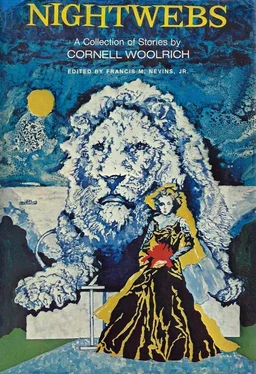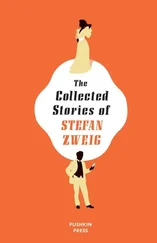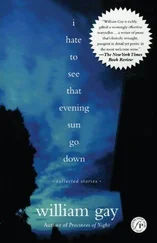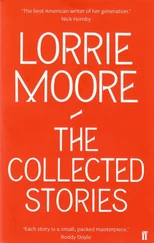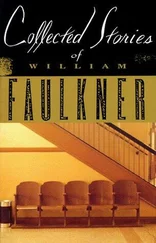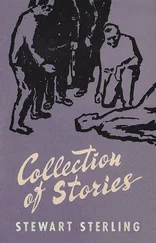Any love, from anywhere, on any terms. Quick, before it was too late! Only not to be alone any longer.
That man is Woolrich and it is we, and that concept is what transforms the clock race from a brilliant device to keep us on the edge of our seats into an organic part of Woolrich’s universe. Characterization and viewpoint are the final points of procedure we have to consider. The way Woolrich portrays the people trapped in these nightmarish situations is a part of the terror of the situations themselves, and yet at the same time the situations in which his people are trapped are vital to his portrayal of the people. For in one sense there are very few villains in Woolrich: if one loves or needs love, and has lost it, or if one is at the brink of death or destruction, Woolrich is with that person, indeed becomes that person, no matter what else the person has done. Even in an incredibly silly story like “The Mystery of the Blue Spot” ( Detective Fiction Weekly , 4/4/36), on the exposure of the truth Woolrich suddenly shifts viewpoints from the investigator to the murderess, who killed because she had lost her love, and who now kills herself. But also in his most powerful work he makes us empathize with all sorts of morally mixed people. He makes us sit, bound and gagged, and paralyzed, with Paul Stapp in his own basement, while the time bomb which Stapp himself has set but now cannot reach ticks closer and closer to “Three O’Clock.” He makes us count the minutes with the murderer Robert Lamont in “Men Must Die” while the executioner, unwittingly poisoned but still functioning, approaches closer and closer to the prison to cut off Lamont’s head. He puts us inside the skins of the dope-crazed King Turner in “Marihuana” and the Depression-crazed Richard Paine in “Murder Always Gathers Momentum” and the grief-crazed Johnny Marr in Rendezvous in Black . He makes us share the last moments of the murderer Gates in “Three Kills for One,” when the cold steel hood falls over his head, and he says in a tired voice, “Helen, I love you,” just before the current fries him: one of the most haunting scenes in Woolrich, and one of the best keys to the man, his world, his way of creating his world, and to how much he longed to love.
Alfred Hitchcock filmed a story by Woolrich in 1954 and another in 1957. Then in 1960 he made Psycho , transforming a good but by no means great novel into one of the most compassionate, savage, and compelling films ever made, a literally inexhaustible work that can be seen over and over with fuller understanding each time. It is worthwhile in closing to consider some of the ties that bind Woolrich to that most disturbed and disturbing of Hitchcock’s creations, the Norman Bates of Psycho . [6] I speak of Hitchcock’s creation, not Robert Bloch’s; for Bloch knew nothing of Woolrich when he wrote his novel and his Norman is a fat repulsive toad not even in the same universe with Hitchcock’s Norman, who is complex and fully human.
Both men were dominated by their mothers throughout their lives and long after the mother’s death; both were trapped by accident of birth, through no fault of their own, in the most wretched psychological conditions; each was gifted (cursed?) with an unobtrusive yet penetrating intelligence that made him deeply aware of his own and all men’s trappedness. The difference between them is that Norman Bates was given no alternative but to translate his nightmares into reality; Woolrich on the other hand was endowed with the ability to take his decades alone and wretched in his personal hell and to shape them into a body of work that theologians must read to understand despair, philosophers to comprehend pessimism, social historians to grasp the Depression, and those concerned with the heart of man to experience through him what it means to be utterly alone. As for plain readers, they will be reading him long after our grandchildren are dust, because he will move and haunt our descendants as he did us and our forebears. He is dead, but he lives. He will outlive us all.
FRANCIS M. NEVINS, JR.
“There he is,” the grave-keeper whispered, parting the hedge so the two detectives could peer through. “That’s the third one he’s gone at since I phoned in to you fellows. I was afraid if I tried to jump on him single-handed he’d get away from me before you got out here. He’s got a gun, see it lying there next to the grave?”
His feeling of inadequacy was understandable; he was not only elderly and scrawny, but trembling all over with nervousness. One of the plainclothesmen beside him unlimbered his gun, thumbed the guard off, held it half-poised for action. The one on the other side of him carefully maneuvered a manacle from his waistband so that it wouldn’t clash.
They exchanged a look across the keeper’s crouched, quaking back, each to see if the other was ready for the spring. Both nodded imperceptibly. They motioned the frightened cemetery-watchman down out of the way. They reared suddenly, dashed through the opening in the hedge simultaneously, with a great crackling and hissing of leaves.
The figure knee-deep in the grave stopped clawing and burrowing, snaked out an arm toward the revolver lying along its lip. One of the detectives’ huge size 12’s came down flat on it, pinning it down. “Hold it,” he said, and his own gun was inches away from the ghoul’s face. A flashlight balanced on a little mound of freshly-excavated soil like a golf-tee threw a thin, ghostly light on the scene. Off to the left one of the other graves was disturbed, wavy with irregular furrows of earth instead of planed flat.
The manacle clashed around the prisoner’s earth-clotted wrist, then the detective’s. They hauled him up out of the shallow trough he had burrowed almost at full arm-length, like a piece of carrion.
“I thought you’d come,” he said. “Where’d you put her? Where is she?”
They didn’t answer, for one thing because they didn’t understand. They weren’t supposed to understand the gibberings of a maniac. They didn’t ask him any questions, either. They seemed to feel that wasn’t part of their job in this case. They’d come out to get him, they’d got him, and they were bringing him in — that was all they’d been sent to do.
One of them stooped for the gun, put it in his pocket; he picked up the torch too, clicked it off. The tableau suddenly went blue-black. They made their way out of the burial-ground with him, the watchman trailing behind them.
Outside the gate a prowl-car was standing waiting; they jammed him into it between them, told the watchman to appear at Headquarters in the morning without fail, shrieked off with him.
He only said one thing more, on the way. “You didn’t have to hijack a patrol car to impress me, I know better than to take you for detectives.” They careened through the midnight city streets stony-faced, one on each side of him, as though they hadn’t heard him. “Fiends,” he sobbed bitterly. “How can the Lord put things like you into human shape?”
He seemed vastly surprised at sight of the Headquarters building, with its green-globed entrance. When they stood him before a desk, with a uniformed lieutenant at it, his consternation was noticeable. He seemed unable to believe his eyes. Then when they led him into a back room, and a captain of detectives came in to question him, there could be no mistaking the fact that he was stunned. “You — you really are!” he breathed.
“What did you think we were?” one of the detectives wanted to know caustically. “CCC boys?”
He looked about uncomprehendingly. “I thought you were — them.”
Читать дальше
